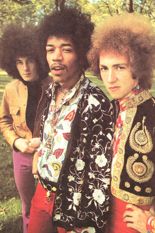
“Hey Joe” seems like it’s been around since the frontier days, but when Jimi Hendrix recorded that tale of a revenge and murder, it was only 5 years old or so.
In that short time, “Hey Joe” — aka “Hey Joe, Where You Gonna Go” — had been covered by the Leaves, Love, the Byrds, the Music Machine, the Shadows of Knight and the Standells, along with every garage band on your old block.
The Leaves hit the charts with their third recording of the number, in 1966, although the year before the song had spread like wildfire through the California rock scene.
Most sources agree that the author was U.S. folkie Billy Roberts, who holds the copyright. The singer-songwriter Dino Valenti was credited as the author on some recordings, although that may have been with Roberts’ blessing.
Tim Rose, who probably started the fiction that “Hey Joe” was a traditional song, took to playing “Hey Joe” as a slow burner. Rose, too, claimed partial songwriting credit.
Hendrix’s version credits Roberts as the writer, but in the liner notes the guitarist calls it “a blues arrangement of an old cowboy song that’s about 100 years old.” Hendrix probably was joking, but it added another red herring to the “Hey Joe” saga. (Read all about the clusterfuck that is “Hey Joe’s” history.)
Tim Rose’s version of “Hey Joe” probably inspired Hendrix to make it part of his act before going to England — the Rose and Hendrix versions are similar in pace, arrangement and vocal backing.
Slowing down high-speed rockers and making them “heavy” was a staple technique of psychedelic rock in those years (see Iron Butterfly, Vanilla Fudge and Blue Cheer), so Hendrix could have have gotten there on his own.
The Jimi Hendrix Experience’s “Hey Joe” opens as a straightforward blues, with Hendrix alternating his vocal delivery a tad to emphasize the question-and-answer format. The female backup singers are fairly hot in the mix, at the request of the guitarist, still trying to find his voice as a frontman.
For the first half, Mitch Mitchell’s drums and Noel Redding’s bass simply keep the beat. As the song moves forward the drumming becomes increasingly aggressive, a suggestion, perhaps, that Joe is starting to lose it. This is a conversation, after all, with a murderer fresh from the kill.
At the 1:40 minute-mark, “Hey Joe” morphs into an Experience song, as Mitchell’s now-busy playing reaches full speed and Redding delivers the signature bass line (used by most bands from “Hey Joe’s” beginning). Hendrix issues a fluid solo, short and simple.
By song’s end, primeval head-banging should be in full effect.
The Jimi Hendrix Experience’s “Hey Joe” of 1966 remains by far the best-known version of the song, and certainly one of the best. It appeared on the first Experience album in the States as the third track on side 1. In England, “Hey Joe” was the group’s first single (b/w “Stone Free” in December 1966) and as such wasn’t included on the album (as was the deal with many Beatles hits). The U.K. omission was made right in the CD era.
Like most of Hendrix’s top songs, “Hey Joe” found its way into several movies and TV series, including “Star Trek: Deep Space Nine.” “Forrest Gump,” “Wayne’s World 2,” “The Wild Life” and “Crooklyn.”

Many popular groups have done a rendition of “Hey Joe.” I enjoy Jimi’s version the most. It is very slow, moving through the circle of fifths. Not too many tunes use that method.
It was written as a “call and response” song. Nobody sings it that way and that is fine with me. Psychedelic? Not hardly. Still one of my favorites from that time. Now… “The Wind Cries Mary” scared me the first time I heard it. So did Purple Haze. I didn’t know what to make of them and that really caught my interest in his stuff.
But why is it a “psychedelic” classic? It’s a rock song with no psychedelic elements.